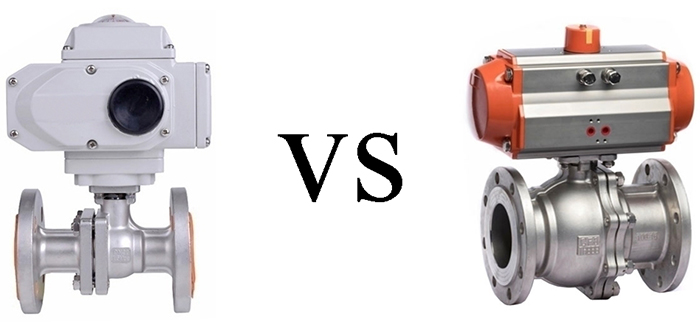Difference between Electric Ball Valve and Pneumatic Ball Valve
Electric ball valves are generally connected to the ball valve by an electric actuator. After debugging through the device, it will become an electric ball valve. The electric ball valve is powered by electric energy, opens the electric actuator to drive the ball valve, completes the switching and conditioning of the ball valve, and then achieves the intention of switching or conditioning the pipeline medium.
Pneumatic ball valve is a ball valve with pneumatic actuator. It is an automatic device that uses compressed air to drive the ball valve to open and close, complete the switching and conditioning of the medium, and then achieve the intention of switching or conditioning the pipeline medium. Pneumatic ball valves are generally equipped with various accessories, such as solenoid valves, air source treatment triple valves, limit switches, positioners, control boxes, etc., to complete local control and remote centralized control. This valve can be opened and closed in the control room. There is no need to go to the site or high altitude, and bring manual control in danger, which greatly saves manpower and safety.

Difference between Electric Ball Valve and Pneumatic Ball Valve
- The essential difference between electric ball valves and pneumatic ball valves is the use of different actuators. Generally, different actuators are selected according to the requirements of working conditions. For example, in chemical and other occasions where explosion-proof is required, pneumatic valves are most used because they are cheap and easy to operate. It also has a smart locator that meets high security requirements.
- Pneumatic ball valves have more force than electric ball valves. The opening and closing action and speed of the pneumatic valve can be adjusted. Simple structure, easy to protect. Due to the buffering properties of the gas itself, it is not easy to be damaged due to blockage during operation. However, it requires an air source and its control system is more complicated than an electric ball valve. The pneumatic ball valve is flexible, safe and reliable. Many places with high control requirements have set up compressed air stations with pneumatic external control components. The power source of the pneumatic actuator is the air source, and the electric control signal is converted into a pneumatic control signal through the positioner to drive the pneumatic actuator to adjust the valve position.
- The power supply of the electric valve actuator is the power supply, and its circuit board or motor is prone to sparks, so it is generally used in places with low environmental requirements and no risk. Pneumatic ball valves are faster than electric ball valves. Under normal circumstances, the opening and closing time of the pneumatic ball valve is about 6 seconds, while the opening and closing time of the electric ball valve is generally 15-20 seconds.
- The advantage of electric ball valve is that it has good effect on liquid medium and large-diameter gas, and is not affected by weather or compressed air pressure. Disadvantages are high cost and poor performance in wet environments. The advantages of pneumatic ball valve are good effect on gaseous medium and small diameter liquid, low cost and convenient protection.
All in all, pneumatic ball valves are better than electric ball valves. The electric ball valve acts quickly and is suitable for places without external air source, but its safety function is poor, and it is not easy to be used in flammable and explosive places with high explosion-proof requirements. During operation, the performance of the electric ball valve is not as stable as that of the pneumatic ball valve, and the cost and maintenance cost are high. But the pneumatic ball valve can fully meet the control requirements, and the device is easy to use. Its safety function is relatively high, and it is suitable for places with high explosion-proof requirements such as flammable and explosive.

